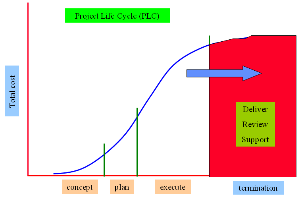Risk management - Project Life Cycle - termination
Project Life Cycle
TERMINATION
Deliver
This is often known as commissioning and handover.
This stage is there to see what the product will actually do in practice (in the field) compared to what it was designed to do.
There should be an assessment of the delivery schedule, the ability to test the product (including availability of equipment) any facility requirements and the level of resource needed to match this commitment.
If the product does not meet its performance criteria then either some changes must be made to the product, which will mean going back to earlier steps, or the expectations of the STAKEHOLDERS which could include the customer must be altered.
Even at this late stage it still possible to CANCEL the project.
Review
This stage must be documented to learn lessons from the project management process.
It is important to allow sufficient resource to draw out the positives and the negatives.
Clearly, if the negatives are not identified there is a real danger that mistakes will be repeated in future projects.
In terms of the performance criteria and other key areas of the project e.g. objectives we should examine more closely how these changed during the project.
In particular, how these changes were handled. There could well be common themes, the knowledge of which will improve the project management process for future projects.
Also, think about the overall RISK MANAGEMENT PROCESS (RMP) and how it performed and where improvements could be made.
Some risks that were identified will not have come to pass. However, those that did occur would have associated RESPONSES.
Were these adequate? If not why not?
As in previous stages, it is important to discuss the method of the review process itself and to evaluate the review process in terms of the relevance of the issues and data raised for the benefit of other projects.
This is discussed in more detail elsewhere [see The Risk Management Process].
At this point there would be no decision point for GO / NO GO / MAY BE.
Support
Despite the apparent completion of the project there will be a need to support the product once in use.
The handover could be either an internal or an external affair.
The amount of support and the duration will be based upon earlier agreements and these should have been considered at length earlier in the project management [see ‘The Complete Project Management package’] and [see 'The Complete Project Management plus PRINCE2'] process when contracts were being discussed in the planning stage.
Are there any potential liabilities at a later date? Legal advisors should have had input here in the earlier design phase.
Depending upon the outcome of the field trials in the ‘deliver’ stage the ‘support’ could either be withdrawn or the product itself could be withdrawn as an extreme case.
This might be the case in the pharmaceutical industry if a drug has adverse effects when used on many real patients or over a prolonged period for example.
If the product is something where experience of its use could influence future manufacture of the same or similar products then support activity can be very important in gaining data for this purpose.



